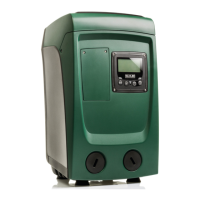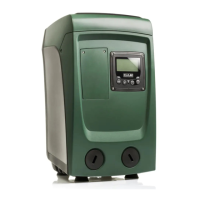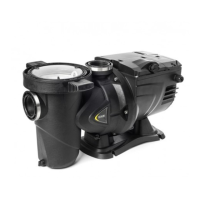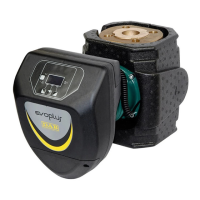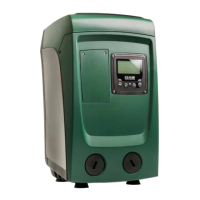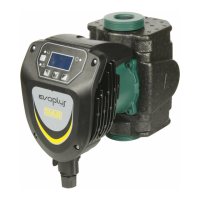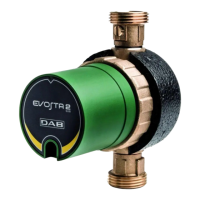ENGLISH
GB
93
7.7.2 NC: Simultaneous devices
Sets the maximum number of devices that can work at the same time.
It may have values between 1 and NA. The default value of NC is NA,
this means that even if NA increases, NC will have the value NA. If a
QXPEHUGLIIHUHQWIURP1$LVVHWWKLVUHOHDVHV\RXIURP1$DQG¿[HV
the maximum number of simultaneous devices at the number set. This
parameter is used in cases where there is a limit on the pumps you can
RUZDQWWREHDEOHWRNHHSUXQQLQJVHH,&&RQ¿JXUDWLRQRIWKH
reserve and other examples below).
On the same menu page you can also see (but not change) the other
two system parameters linked to this, that is N, the number of devices
present, read automatically by the system, and NA, the number of active
devices.
,&&RQ¿JXUDWLRQRIWKHUHVHUYH
&RQ¿JXUHVWKHGHYLFHDVDXWRPDWLFRUUHVHUYH,IVHWRQDXWRGHIDXOW
WKHGHYLFHSDUWLFLSDWHVLQQRUPDOSXPSLQJLIFRQ¿JXUHGDVUHVHUYHV
minimum starting priority is associated with it, this means that the device
with this setting will always start last. If a number of active devices is set
that is one lower than the number of devices present and if one element
is set as reserve, the effect obtained is that, if there are no problems, the
reserve device does not participate in regular pumping; instead, if one of
the devices that participates in pumping develops a fault (maybe loss of
power supply, tripping of a protection, etc.), the reserve device will start.
7KHVWDWHRIFRQ¿JXUDWLRQDVDUHVHUYHFDQEHVHHQDVIROORZVRQWKH
Multi-pump System page, the top of the icon is coloured; on the AD and
main pages, the communication icon representing the address of the
device appears with the number on a coloured background. There may
EHPRUHWKDQRQHGHYLFHFRQ¿JXUHGDVUHVHUYHLQDSXPSLQJV\VWHP
(YHQWKRXJKWKHGHYLFHVFRQ¿JXUHGDVUHVHUYHGRQRWSDUWLFLSDWHLQQRU-
PDOSXPSLQJWKH\DUHQHYHUWKHOHVVNHSWHI¿FLHQWE\WKHDQWLVWDJQDWLRQ
algorithm. The anti-stagnation algorithm changes the starting priority
once every 23 hours and allows the accumulation of at least one continu-
RXVPLQXWHRIVXSSO\RIÀRZIURPHDFKGHYLFH7KHDLPRIWKLVDOJRULWKP
is to avoid the deterioration of the water inside the impeller and to keep
WKHPRYLQJSDUWVHI¿FLHQWLWLVXVHIXOIRUDOOGHYLFHVDQGHVSHFLDOO\IRU
WKRVHFRQ¿JXUHGDVUHVHUYHZKLFKGRQRWZRUNLQQRUPDOFRQGLWLRQV
of this control depends on the set GP and GI parameters. To cope with
the different behaviour of the various types of hydraulic plants where the
system can work, the inverter allows the selection of parameters different
from those set by the factory. For nearly all plants the factory-set GP
and GI parameters are optimal. However, should any problems occur in
adjustment, these settings may be varied.
*,,QWHJUDOJDLQFRHI¿FLHQW
IIn the presence of large falls in pressure due to a sudden increase of the
ÀRZRUDVORZUHVSRQVHRIWKHV\VWHPLQFUHDVHWKHYDOXHRI*,,QVWHDG
if there are swings in pressure around the setpoint value, decrease the
value of GI.
IMPORTANT: To obtain satisfactory pressure adjustments, you gener-
ally have to adjust both GP and GI
7.6.6 - RM: Maximum speed
ISets a maximum limit on the number of pump revolutions.
7.7 - Setting the number of devices and of reserves
7.7.1 - NA: Active devices
Sets the maximum number of devices that participate in pumping.
It may have values between 1 and the number of devices present (max
4). The default value for NA is N, that is the number of devices present
in the chain; this means that if devices are added to or removed from
the chain, NA always has the value of the number of devices present,
DXWRPDWLFDOO\GHWHFWHG,IDQXPEHUGLIIHUHQWIURP1LVVHWWKLV¿[HV
the maximum number of devices that can participate in pumping at the
number set.
This parameter is used in cases where there is a limit on the pumps you
can or want to be able to keep running, and if you want to keep one or
PRUHGHYLFHVDVDUHVHUYHVHH,&&RQ¿JXUDWLRQRIWKHUHVHUYH
and other examples below).
On the same menu page you can also see (but not change) the other two
system parameters linked to this, that is N, the number of devices pres-
ent, read automatically by the system, and NC, the maximum number of
simultaneous devices.
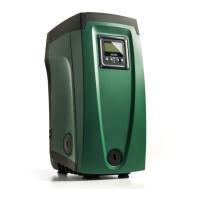
